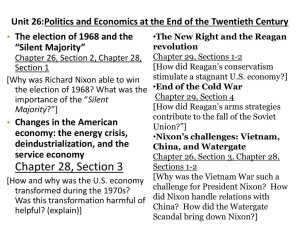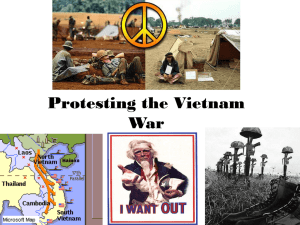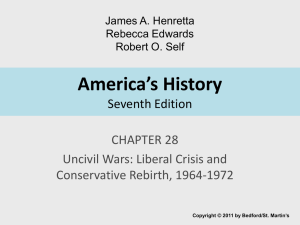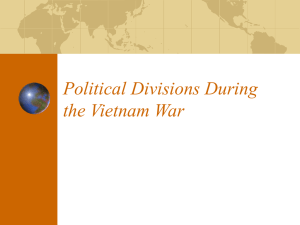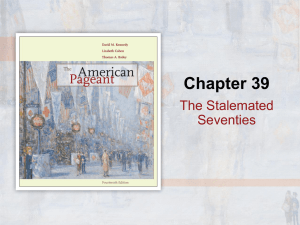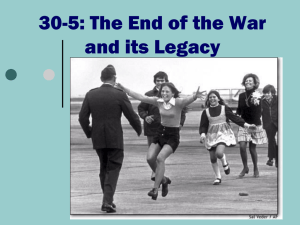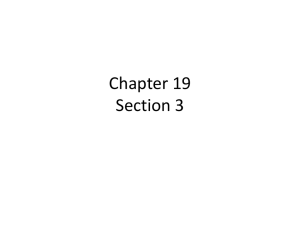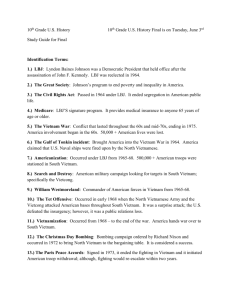The Rise of Conservatism Lecture
advertisement
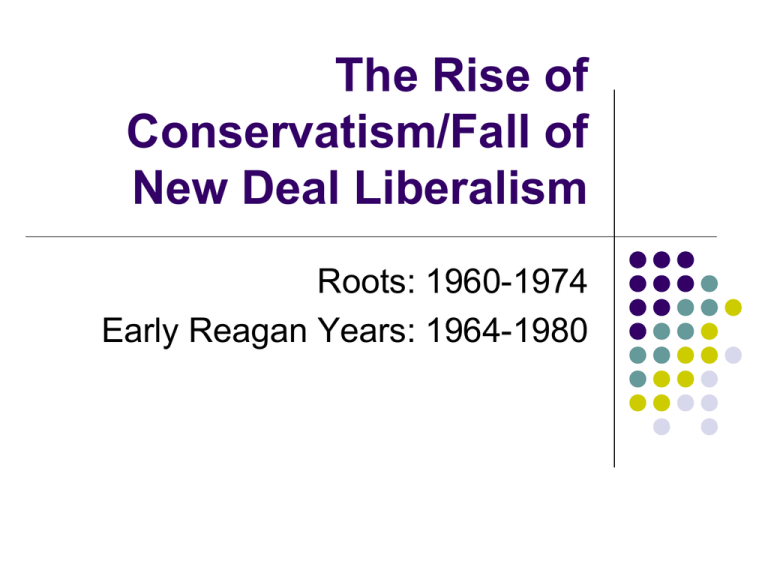
The Rise of Conservatism/Fall of New Deal Liberalism Roots: 1960-1974 Early Reagan Years: 1964-1980 “Conservative” vs. Republican? Conservatives Tea Party States rights Low taxes Small govt. Strict constitutionalists Traditional values Pro-defense Anti-abortion Anti-gay-rights Gun rights Republicans Southern whites Evangelical Christians Wealthy Pro-business Small govt. Libertarians Military Isolationists? Suburban or rural Anti-entitlement The Republican Party’s Tortured Past: A Conservative Party? Conflicting ideals; divisions; which way? Civil War Radical Republicans = Big Govt. to protect civil rights Gilded Age Republicans = Big Govt. for Business, small govt. for everyone else Early 20th-century Divisions between small govt., laissez-faire and Teddy Roosevelt Bull Moosers New Deal era = years in the political wilderness 1950s = moderate Republican Eisenhower 1950s = redbaiting and divisive politics for others Young Americans for Freedom, Sharon Statement, 1960 Conservative radicals trying to retake America and Republican Party Main ideals? The New Republican Majority Peel off segments of the New Deal coalition? On what issues?: African Americans? Liberals? Southern white Democrats? White ethnics (descendants of New Immigrants, Catholics, Jews)? Workers? Democratic Mistakes Democrats alienated major parts of their electoral coalition: Liberals and Leftists – (issues?) Working-Class White Ethnics Women Southern whites African Americans 1960s/1970s Democratic Mistakes Ways Democrats Alienated Voters? Vietnam decisions and actions Alienated liberals and left-leaning radicals – pro-peace Liberals/left, Not enough on civil rights From the right – too permissive of demonstrations, “chaos” From the left – liberals not very liberal From the right – too liberal on civil rights, ruining the social structure Economy? Spending money on social welfare programs, Great Society Perception of spending money on black people Association with black and urban riots, decaying cities, loss of control – Law and Order George Wallace: Southern Democrat, Republican Ideas Rebuild white Democratic Party in south Retake Democratic Party for white people Opposed civil rights legislation and activism Appealed to southern AND northern whites to run for president in 1960s and 1970s Used race as focal point for campaign Changed language of racism: from blame the “niggers” to blame the lawless, criminals, people on welfare George Wallace Alabama Governor & Presidential Candidate (Dem.) George Wallace Nixon, Vietnam & Watergate: Effects on the Political Landscape Nixon’s Foreign Policies and Actions Focus on Big Fish – wanted to open up trade, talks with China and USSR, decrease Cold War tension Vietnam - Policy of Vietnamization – turn over war to South Vietnamese army Secrecy - secret bombings of N.V., Cambodia, Laos; secret negotiations w/ N.V. U.S. detachment from Vietnam conflict – use rhetoric of peace and withdrawal, while continuing bombings to force N.V. to accept split Vietnam Heightened rhetoric against protesters = protesters were anti-American, helping North Vietnam Richard Nixon Nixon Nixon and New Republican Majority Vietnamization Nixon ran for president in 1967-8 on platform of “Vietnamization” – transfer of military operations in Vietnam to the South Vietnamese military Video clip on Vietnamization Secret Wars: Cambodia & Laos Publicly, Nixon pushed Vietnamization, gradual withdrawal from Vietnam, and peace talks In secret, he began bombings and military missions in Vietnam, Cambodia, and Laos, expanding the war Official U.S. involvement in Vietnam lasted 6 years under Nixon, longer than under LBJ Video Clip on Bombings & Secret Wars Nixon’s Political Strategies Kevin Phillips’, ‘Emerging Republican Majority’: Republicans could win (and did) from 1968-1992 Southern Strategy – use “hostility to blacks and browns” as political strategy (idea from George Wallace) Get white Catholics, ethnic whites, and white southerners to permanently switch to GOP Appeal to ‘Silent Majority’ of Americans: patriotic, anti-protester, anti-urban Law and Order campaign: used images of riots, protests, and fear to sway voters Silent Majority of Americans were the real victims (of protests, draft, taxes, civil rights, economy) The Silent Majority: Taxi Driver’s Travis Bickle ‘All the animals come out at night’ clip ‘Late for the sky’ scene clip Watergate Link to film clips, Nixon: The Fall Connections to Vietnam War Nixon’s insecurity and fear of political opposition Use of FBI to spy on and undermine antiwar and civil rights movements Political dirty tricks to hurt political rivals Covered up instead of coming clean Nixon and Conservatism: Conclusions Nixon’s foreign policies towards China and USSR were fairly successful, opened up lines of communication Deceitful policies in Vietnam: rhetoric of peace, while bombing and prolonging war U.S. involvement in Vietnam War dragged on for 6 more years as he used it as pawn in larger foreign policy Nixon’s southern strategy and appeals to ‘silent majority’ widened political and social rifts in U.S. Watergate and corruption further weakened people’s trust in government Republicans benefited in long run from increasing distrust of government Nixon and Watergate helped Conservatives in the long run? General distrust of government Helped Republicans’ argument against too much government Dems handling of impeachment alienated the public – fatigue Helped purge Nixon (moderate on foreign policy and economy) from party – purified party – door open to conservatives Reagan, ‘A Time for Choosing,’ 1964 Part One Reagan, ‘A Time for Choosing,’ 1964 Part Two (text) Reagan, ‘A Time for Choosing,’ 1964 Part Three Carter’s ‘Crisis of Confidence’ speech, July, 1979 Reagan’s 1980 Acceptance Speech Modern Conservatism Rise of Christian Right, evangelicals ‘With God on Our Side’ documentary, part one Cultural issues: religion, abortion, prayer in schools, homosexuality, ERA, women’s issues, gender issues Diff. political action groups, organizations, like the Moral Majority Problems of keeping coalition together: religious conservatives, economic, foreign policy, libertarians 1980s: ‘Wall Street’ America Wall Street clips
